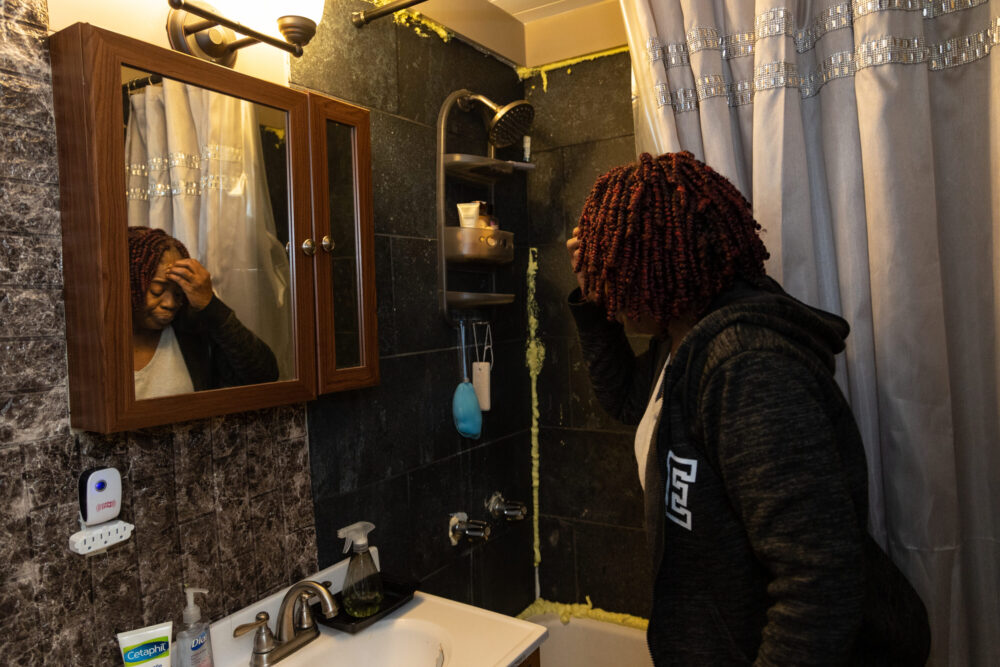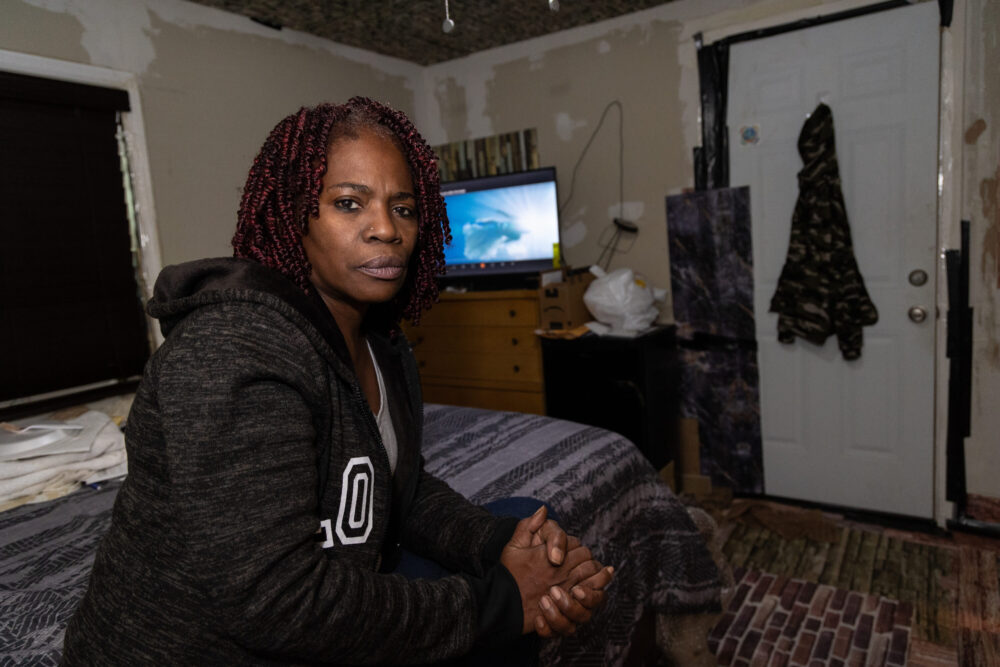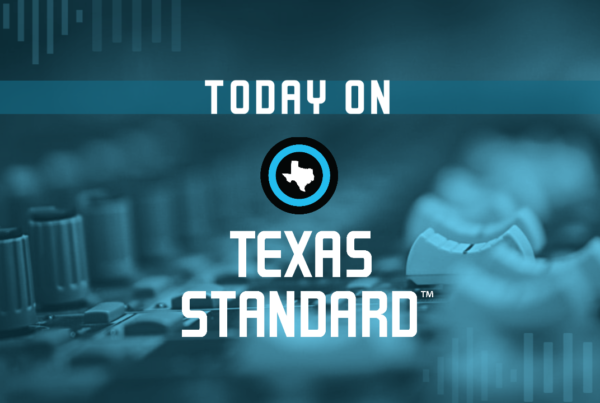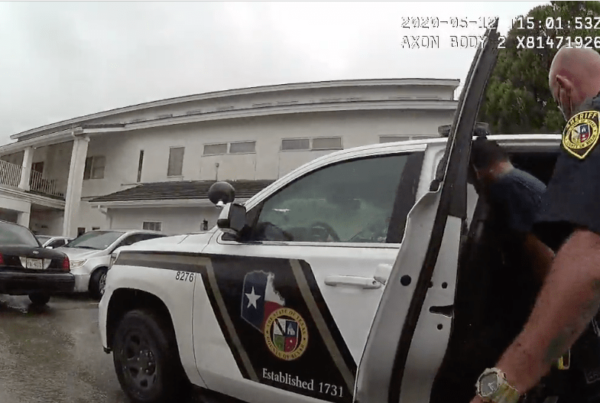The first night of Winter Storm Uri, when temperatures went below freezing, Sandra Edwards woke up on her bedroom floor, soaking wet, lying on her back.
Edwards, a community activist who lives with her two cats in Fifth Ward, has no idea what knocked her unconscious, but believes she stepped out of bed and slipped on ice that formed on the ground.
“I had icicles hanging from my ceiling,” Edwards said. “I had ice on the floor.”
Physically Edwards recovered, but one year after the freeze her house is still just as vulnerable to damage.
For many like Edwards who live in underserved and under-resourced neighborhoods across the region, the winter freeze just exacerbated home damage from previous disasters like Hurricane Harvey.
Now many of those Houstonians are still waiting for disaster aid and have few resources if another storm were to hit, making them even more vulnerable than when the winter storm came through in February 2021 – and have no real assurance the situation would be better if a storm happened tomorrow. In fact, they’re in worse shape.
A year ago, temperatures across the state plummeted, in many cases to below freezing. Many Texans had snow flurries in their backyards, and millions lost power for days or even weeks. People also went without water in major cities, including Houston, which had a boil water advisory for three days. According to a report from the Texas Department of State Health Services, 246 Texans died as a result of the storm. Harris County had 43 deaths, the most of any county in the state.
Texas has its own electric grid, which is different from how other states get power. That grid wasn’t designed with winter weather in mind. When Texans started to crank up their heat during the freeze, it threatened the grid’s stability. The Electric Reliability Council of Texas (ERCOT) manages the grid and implemented rolling blackouts to keep it from shutting down.
After the outages, Texas lawmakers enacted legislation they said would improve the state’s electricity system. Still, experts say the grid is vulnerable.
Some people already entered Winter Storm Uri at a disadvantage. Edwards, whose home was so damaged by Harvey that she was displaced for two years, only had one liveable room by the time temperatures started to drop below freezing last February.

It was in that one room where she found herself cold and wet and on the floor. Edwards says because of existing damage, water seeped into her house and onto her floors, and froze over when temperatures plunged.
Like many Houstonians, she also lost power. In Edwards’ case, her house was without electricity for four days.
“It’s crazy because our system has failed us left and right,” Edwards said. “We don’t know what to do no more, so it’s just like we’re playing Russian roulette.”
For two of the four days she spent without power, Edwards said she relied on a generator for heat and electricity. She was concerned about more water leaking into her home, which one year later still has mold damage.
“I stayed in here and I endured,” Edwards said. “I cleaned as much as I could, I bought gallons of bleach and ammonia, and did what I could.”
Edwards said a lot of her neighbors have the same issues, and some have stopped even looking for assistance, making do with homes in disrepair.
On top of that, billions of dollars in debt that companies incurred from the storm will be passed onto Texas ratepayers over the next 20 years.
Edwards says that isn’t right.
“If you catch hell, don’t pass it on to us,” she said. “We’re already catching hell here. Why would you pass your problem onto us and make us pay for it? If you fixed the grid, we wouldn’t have this problem.”
She hopes electricity providers will have some grace for people who are unable to pay some or all of their bills after being hit by multiple disasters like Harvey and Winter Storm Uri.

But electricity bills are going up for Houstonians: As the economy began to rebound from the pandemic thanks to increasing COVID-19 vaccine availability, consumer electricity prices started to rise by the end of the year, according to the U.S. Energy Information Administration (EIA).
Wholesale prices went up across the country, according to the EIA, but were especially volatile in the ERCOT market last year because of the freeze. In hopes of enticing more power generators to contribute electricity to the grid during the storm, ERCOT allowed the price of wholesale electricity to reach its maximum of $9,000 per megawatt hour, or $9 per kilowatt hour. Texas residents normally pay between 12 and 20 cents per kilowatt hour.
Although the Texas electricity market works differently than the rest of the country – mostly thanks to the now disgraced company Enron pushing state lawmakers to deregulate the market in the 1990s – Texas is still the country’s main supplier of natural gas used to generate electricity, according to the EIA.
The freeze in February 2021 disrupted that natural gas supply, and from there it was basic economics: less supply met with more demand – people turning on the heat – meant prices went up, and natural gas prices have largely stayed elevated since then. That’s translated to increased electricity bills across the country.
Texans face even higher prices in the coming decades due to the storm. State lawmakers approved $6.5 billion in ratepayer bonds to pay back losses some utilities and generators experienced during the freeze. Essentially, companies that incurred major costs are able to pass on those costs to residents on their electricity bills over the next 20 years.
Ed Hirs, an energy fellow at the University of Houston, said passing on those costs to the customer is a “great fleecing of American consumers.” Incurring that cost, he said, could be damaging for people still trying to fix their homes after repeated storm damage. Meanwhile, generator companies stand to make billions off of energy consumers, with charges likely to start showing up on electric bills next month.
The costs will hit all Houstonians, but Hirs said the greater burden will fall on the shoulders of Houston’s poorest residents – similar to how the city’s poorest residents suffered more acutely because of a lack of access to food, fuel and insulation that the city’s wealthier residents have.
“The folks in River Oaks, they have tremendous resources,” he said. “Folks who are poor are not living in well-insulated houses. There are many, many more of them in Harris County than there are people in River Oaks.”
Tenants of Northside Houston’s Coppertree Village Apartments, an affordable housing complex that rents units based on a percentage of the tenant’s income, were already in an ongoing legal battle with the U.S. Department of Housing and Urban Development over their living conditions: Tenants say they are living with mold, sewage, crime, and other hazards.
Coppertree was also hit hard by the winter storm, and Erica Bowman, a community organizer at Texas Housers who works with tenants there, said dealing with its impacts on top of those dangerous living conditions was devastating.
“When storms come and they go, it does just add onto the struggle that they’re already facing,” she said. “But they have equipped themselves with figuring out ways of coming together to try to make it through.”
Tenants said last year’s intense cold front knocked power out at Coppertree for two weeks. Cheryl Potts, who lives in a two-bedroom unit there with her 17-year-old grandson, said the power would cut in and out during the second week. The first week didn’t have any power at all.
After going hungry for a day when the power first went out, Potts said she cooked her food on her barbecue pit outside.
“I didn’t want all of my food to go bad, so I cooked as much as I could,” she said.
Kenneth Hawkins, who also lives in Coppertree, said he cooked chicken and rice on his grill. When the power came back on for good, Hawkins said he felt like he had won the lottery.
“I was so happy,” he said. “I was running out of charcoal and wood for my barbecue pit.”
Then, he got his electric bill.
Even though Hawkins didn’t have power for two weeks, he said the bill for his one-bedroom unit doubled from the usual $60 charge.
For people with limited incomes like Potts and Hawkins, an increase in their electric bill has a major impact on their budget. Hirs, with UH, said the financial burden of rising electricity costs disproportionately falls on the poor.
But paying for electricity doesn’t guarantee reliability. Under the ERCOT model, consumers are only paying for electricity, not reliable power.
The residents at Coppertree say the reliability of the electricity is volatile; Potts and Hawkins both said outages are common at the complex. Every month or so, the power will go out for a couple of hours or more. The tenants say nothing has been done to fix the issue, so they’ve come to expect it.
Residents also fear another weeks-long outage. When temperatures dropped down to freezing earlier this month, Potts bought candles just in case.
“I really am worried,” she said.
Houston didn’t end up experiencing any major power outages when the city had freezing temperatures for a few days at the beginning of this February, but Hirs said if it had been a storm of the same magnitude as Uri, we would have likely seen another round of widespread outages and other damage.
Although the governor and legislature said fixing the grid was a top priority in 2021, Hirs says 20% of power generators in the state are probably not ready for another Winter Storm Uri.
Legislation to fix the grid did call for weatherization, but wasn’t specific enough, he added. And on top of that, he said the changes made to ERCOT and other aspects of the electricity market puts more control in the hands of the governor.
“These are the guys who got you into trouble in the first place,” he said. “And now with the board of ERCOT comprised of political appointees, I’m very concerned about the direction.”













